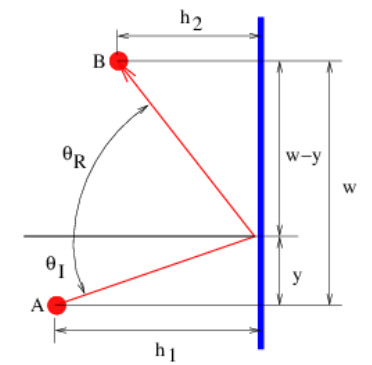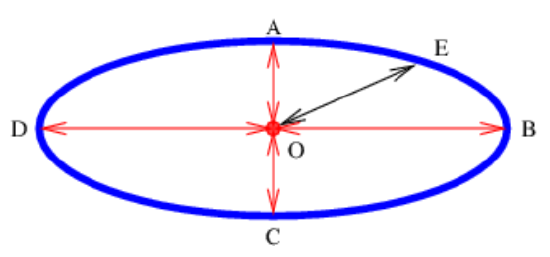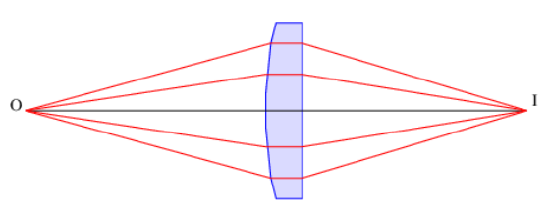3.5: Fermat’s Principle
( \newcommand{\kernel}{\mathrm{null}\,}\)
An alternate approach to geometrical optics can be developed from Fermat’s principle. This principle states (in its simplest form) that light waves of a given frequency traverse the path between two points which takes the least time. The most obvious example of this is the passage of light through a homogeneous medium in which the speed of light doesn’t change with position. In this case the shortest time corresponds to the shortest distance between the points, which, as we all know, is a straight line. Thus, Fermat’s principle is consistent with light traveling in a straight line in a homogeneous medium.

Fermat’s principle can also be used to derive the laws of reflection and refraction. For instance, Figure 3.5.10: shows a candidate ray for reflection in which the angles of incidence and reflection are not equal. The time required for the light to go from point A to point B is
t=([h21+y2]1/2+[h22+(w−y)2]1/2)/c
where c is the speed of light. We find the minimum time by differentiating t with respect to y and setting the result to zero, with the result that
y[h21+y2]1/2=w−y[h22+(w−y)2]1/2
However, we note that the left side of this equation is simply sin θI, while the right side is sin θR, so that the minimum time condition reduces to sin θI = sin θR or θI = θR, which is the law of reflection.

A similar analysis may be done to derive Snell’s law of refraction. The speed of light in a medium with refractive index n is c ∕ n, where c is its speed in a vacuum. Thus, the time required for light to go some distance in such a medium is n times the time light takes to go the same distance in a vacuum. Referring to Figure 3.5.11:, the time required for light to go from A to B becomes
t=([h21+y2]1/2+n[h22+(w−y)2]1/2)/c
This results in the condition
sinθI=nsinθR
where θR is now the refracted angle. We recognize this result as Snell’s law.
Notice that the reflection case illustrates a point about Fermat’s principle: The minimum time may actually be a local rather than a global minimum — after all, in Figure 3.5.10:, the global minimum distance from A to B is still just a straight line between the two points! In fact, light starting from point A will reach point B by both routes — the direct route and the reflected route.

It turns out that trajectories allowed by Fermat’s principle don’t strictly have to be minimum time trajectories. They can also be maximum time trajectories, as illustrated in Figure 3.5.12:. In this case light emitted at point O can be reflected back to point O from four points on the mirror, A, B, C, and D. The trajectories O-A-O and O-C-O are minimum time trajectories while O-B-O and O-D-O are maximum time trajectories.
Fermat’s principle seems rather mysterious. However, the American physicist Richard Feynman made sense out of it by invoking an even more fundamental principle, as we now see.
If a light ray originates at point O in Figure 3.5.12:, reflects off of the ellipsoidal mirror surface at point A, and returns to point O, the elapsed time isn’t much different from that experienced by a ray which reflects off the mirror a slight distance from point A and returns to O. This is because at point A the beam from point O is perpendicular to the tangent to the surface of the mirror at point A. In contrast, the time experienced by a ray going from point O to point E and back would differ by a much greater amount than the time experienced by a ray reflecting off the mirror a slight distance from point E. This is because the tangent to the mirror surface at point E is not perpendicular to the beam from point O.
Technically, the change in the round trip time varies linearly with the deviation in the reflection point from point E, but quadratically with the deviation from point A. If this deviation is small in the first place, then the change in the round trip time will be much smaller for the quadratic case than for the linear case.
It seems odd that we would speak of a beam reflecting back to point O if it hit the mirror at any point except A, B, C, or D, due to the requirements of the law of reflection. However, recall that the law of reflection itself depends on Fermat’s principle, so we cannot assume the validity of that law in this investigation.
Feynman postulated that light rays explore all possible paths from one point to another, but that the only paths realized in nature are those for which light taking closely neighboring paths experiences nearly the same elapsed time (or more generally, traverses nearly the same number of wavelengths) as the original path. If this is true, then neighboring rays interfere constructively with each other, resulting in a much brighter beam than would occur in the absence of this constructive interference. Thus, the round-trip paths O-A-O, O-B-O, O-C-O, and O-D-O in Figure 3.5.12: actually occur, but not O-E-O. Feynman explains Fermat’s principle by invoking constructive and destructive interference!

Figure 3.5.13: illustrates a rather peculiar situation. Notice that all the rays from point O which intercept the lens end up at point I. This would seem to contradict Fermat’s principle, in that only the minimum (or maximum) time trajectories should occur. However, a calculation shows that all the illustrated trajectories in this particular case take the same time. Thus, the light cannot choose one trajectory over another using Fermat’s principle and all of the trajectories are equally favored. Note that this inference applies not to just any set of trajectories, but only those going from an object point to the corresponding image point.


